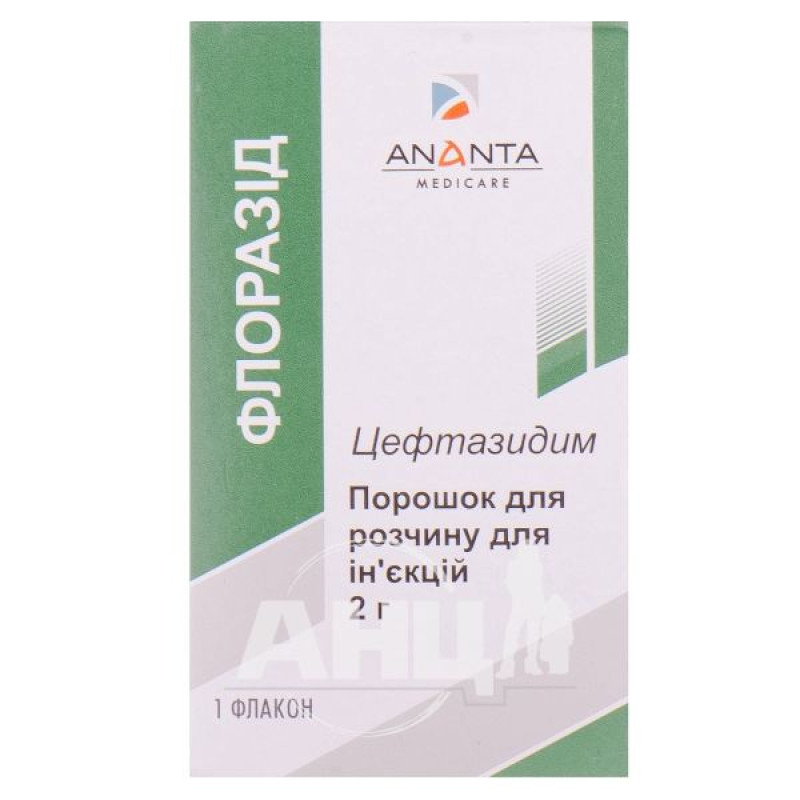Florazid powder for solution for injection 2 g bottle No. 1

"Florazid" powder for solution for injection is used for the indications listed below.
Treatment of the following infections in adults and children, including newborns:
hospital-acquired pneumonia; respiratory tract infections in patients with cystic fibrosis; bacterial meningitis; chronic otitis media; malignant otitis externa; complicated urinary tract infections; complicated skin and soft tissue infections; complicated intra-abdominal infections; bone and joint infections; dialysis-associated peritonitis in patients on continuous ambulatory peritoneal dialysis.Treatment of bacteremia occurring in patients as a result of any of the above infections.
Ceftazidime can be used to treat patients with neutropenia and fever resulting from a bacterial infection.
Ceftazidime can be used to prevent infectious complications during prostate surgery (transurethral resection).
When prescribing ceftazidime, its antibacterial spectrum, directed mainly against gram-negative aerobes, should be taken into account.
Ceftazidime should be used with other antibacterial agents if it is expected that the range of microorganisms causing the infection is not within the spectrum of activity of ceftazidime.
The drug should be prescribed in accordance with existing official recommendations for the prescription of antibacterial agents.
Composition
The active substance is ceftazidime (1 vial contains ceftazidime (in the form of ceftazidime pentahydrate) 2 g).
The excipient is sodium carbonate.
Contraindication
Hypersensitivity to ceftazidime or any of the excipients; Hypersensitivity to cephalosporin antibiotics; History of severe hypersensitivity (e.g. anaphylactic reactions) to other beta-lactam antibiotics (penicillins, monobactams and carbapenems).Method of application
Adults and children weighing ≥ 40 kg
Intermittent input:
respiratory tract infections in patients with cystic fibrosis - 100-150 mg/kg/day every 8 hours, maximum up to 9 g per day; febrile neutropenia, hospital-acquired pneumonia, bacterial meningitis, bacteremia - 2 g every 8 hours; bone and joint infections, complicated skin and soft tissue infections, complicated intra-abdominal infections, peritonitis (associated with continuous ambulatory peritoneal dialysis) - 1-2 g every 8 hours; complicated urinary tract infections - 1-2 g every 8 hours or 12 hours; prevention of infectious complications during prostate surgery (transurethral resection) - 1 g during induction of anesthesia, 1 g at the time of catheter removal; chronic otitis media, malignant otitis externa - 1-2 g every 8 hours.Continuous infusion: febrile neutropenia, hospital-acquired pneumonia, respiratory tract infections in patients with cystic fibrosis, bacterial meningitis, bacteremia, bone and joint infections, complicated skin and soft tissue infections, complicated intra-abdominal infections, peritonitis (associated with continuous ambulatory peritoneal dialysis) - a loading dose of 2 g is administered followed by a continuous infusion of 4 to 6 g every 24 hours.
Children weighing <40 kg
Intermittent administration (infants and children > 2 months and weighing < 40 kg):
complicated urinary tract infections, chronic otitis media, malignant otitis externa - 100-50 mg/kg/day in 3 divided doses, maximum 6 g/day; neutropenia in children, respiratory tract infections in patients with cystic fibrosis, bacterial meningitis, bacteremia - 150 mg/kg/day in 3 divided doses, maximum 6 g/day; bone and joint infections, complicated skin and soft tissue infections, complicated intra-abdominal infections, peritonitis (associated with continuous ambulatory peritoneal dialysis) - 100-50 mg/kg/day in 3 divided doses, maximum 6 g/day.Continuous infusion (infants and children > 2 months and < 40 kg): febrile neutropenia, hospital-acquired pneumonia, respiratory tract infections in patients with cystic fibrosis, bacterial meningitis, bacteremia, bone and joint infections, complicated skin and soft tissue infections, complicated intra-abdominal infections, peritonitis (associated with continuous ambulatory peritoneal dialysis) - a loading dose of 60-100 mg/kg body weight is administered, followed by a continuous infusion of 100-200 mg/kg body weight per day, up to a maximum of 6 g per day.
Intermittent administration (infants and children ≤ 2 months): most infections - 25-60 mg/kg/day in 2 divided doses.
Application features
Pregnant women
Data on the use of ceftazidime in pregnant women are limited. Ceftazidime should be used during pregnancy only if the potential benefit outweighs the potential risk.
Ceftazidime is excreted in breast milk in small amounts, but at therapeutic doses, no effects on breast-fed infants are expected. Ceftazidime can be used during breast-feeding.
Drivers
No relevant studies have been conducted. However, the occurrence of adverse reactions such as dizziness may affect the ability to drive or use other mechanisms.
Overdose may result in neurological complications such as encephalopathy, convulsions and coma. Symptoms of overdose may occur in patients with renal insufficiency unless the dose is reduced accordingly. Serum ceftazidime concentrations can be reduced by haemodialysis or peritoneal dialysis.
Side effects
Blood and lymphatic system: often (≥ 1/100 and <1/10) - eosinophilia and thrombocytosis.
Vascular disorders: often (≥ 1/100 and <1/10) - phlebitis or thrombophlebitis at the site of drug administration.
Gastrointestinal disorders: common (≥ 1/100 and <1/10) - antibiotic-associated diarrhea.
Hepatobiliary reactions: often (≥ 1/100 and <1/10) - transient increase in the level of one or more liver enzymes (ALT, AST, LDH, GGT, LF).
Skin and subcutaneous tissue disorders: common (≥ 1/100 and < 1/10) - maculopapular rash or urticaria.
Storage conditions
Store in the original packaging at a temperature not exceeding 25 °C, out of the reach of children. The prepared solution can be stored for no more than 8 hours at a temperature not exceeding 25 °C and for no more than 24 hours at a temperature from 2 °C to 8 °C.
Shelf life - 2 years.
There are no reviews for this product.
There are no reviews for this product, be the first to leave your review.
No questions about this product, be the first and ask your question.




